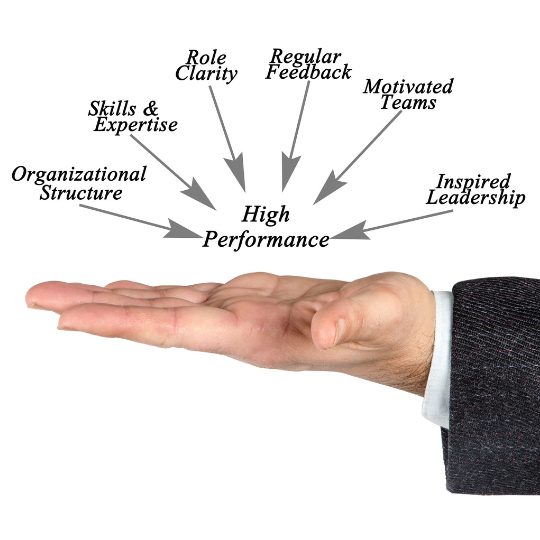The Secret to Becoming a High Performance Leader
In the ever-evolving landscape of leadership, one question remains constant: What sets high-performance leaders apart from the rest? As organizations strive for excellence and seek to navigate through complexities, the quest for effective leadership becomes paramount. In this blog post, we uncover the elusive secret behind becoming a high-performance leader – a topic that transcends industries, cultures, and time itself. Through meticulous research and real-world examples, we delve into the core attributes, strategies, and mindset that define exceptional leadership. From fostering a culture of innovation to mastering the art of communication, the journey to becoming a high-performance leader is multifaceted and dynamic. Whether you're a seasoned executive, an aspiring manager, or an individual seeking personal growth, this exploration into the heart of leadership promises valuable insights and actionable takeaways. Join us as we uncover the principles that empower leaders to not only navigate challenges but to thrive amidst them.
Mastering the Art of Effective Communication
Effective communication is the cornerstone of successful leadership. It's not just about conveying information; it's about building relationships, inspiring action, and fostering collaboration within your team. In this article, we'll explore the essential communication skills that distinguish high-performance leaders and provide practical tips for mastering the art of effective communication.
Active Listening
High-performance leaders understand the importance of active listening. This means fully concentrating on what others are saying, understanding their perspective, and responding thoughtfully. Active listening builds trust, encourages open dialogue, and helps leaders make more informed decisions. To practice active listening, focus on maintaining eye contact, asking clarifying questions, and summarizing key points to demonstrate understanding.
Clear and Concise Messaging
Clarity is key when communicating with your team. High-performance leaders have the ability to distill complex ideas into clear and concise messages that resonate with their audience. Avoid jargon and unnecessary details, and instead focus on delivering information in a straightforward manner. Use simple language, concrete examples, and visual aids to enhance understanding and retention.
Empathy and Understanding
Empathy is a fundamental aspect of effective communication. High-performance leaders take the time to understand the thoughts, feelings, and concerns of their team members. By showing empathy and compassion, leaders build stronger connections and create a supportive work environment where individuals feel valued and respected. Practice active empathy by acknowledging others' emotions, validating their experiences, and offering support when needed.
Tailoring Communication to Different Audiences
Not all communication styles are created equal. High-performance leaders understand the importance of adapting their communication approach to suit different audiences and situations. Whether speaking to senior executives, frontline employees, or clients, it's essential to tailor your message to resonate with your audience. Consider their knowledge level, preferences, and communication style to ensure your message is received effectively.
Inspiring Motivation and Engagement
Effective communication has the power to inspire motivation and engagement within your team. High-performance leaders use storytelling, persuasion, and vision casting to inspire others and rally them behind a common goal. By articulating a compelling vision and highlighting the significance of individual contributions, leaders can ignite passion and drive performance. Be authentic, passionate, and enthusiastic in your communication to inspire others to action.
Cultivating Resilience in the Face of Adversity
Resilience is the ability to bounce back from setbacks, adapt to change, and thrive in the face of adversity. In today's fast-paced and unpredictable world, cultivating resilience is essential for navigating challenges and achieving success as a leader. In this article, we'll explore the characteristics of resilient leaders and provide practical strategies for building resilience in yourself and your team.
Understanding Resilience
Resilience is not about avoiding adversity; it's about facing challenges head-on and emerging stronger on the other side. Resilient leaders possess a positive mindset, adaptability, and the ability to persevere in the face of setbacks. They view failures as opportunities for growth, maintain a sense of optimism, and remain focused on finding solutions rather than dwelling on problems.
Building Emotional Strength
Emotional resilience is a cornerstone of effective leadership. Resilient leaders have the ability to manage their emotions, stay calm under pressure, and maintain perspective during difficult times. They practice self-awareness, mindfulness, and self-regulation techniques to cope with stress and adversity. By cultivating emotional strength, leaders can inspire confidence and stability within their teams, even in challenging circumstances.
Developing a Growth Mindset
A growth mindset is essential for building resilience. Resilient leaders embrace challenges as opportunities for learning and growth, rather than viewing them as insurmountable obstacles. They believe in their ability to develop new skills, adapt to change, and overcome setbacks through effort and perseverance. Encourage a growth mindset within your team by promoting a culture of continuous learning, experimentation, and resilience-building.
Building Strong Support Networks
Resilient leaders understand the importance of social support in times of adversity. They cultivate strong relationships with colleagues, mentors, and peers who can provide encouragement, guidance, and perspective during difficult times. Building a supportive network not only helps leaders navigate challenges more effectively but also fosters a sense of belonging and camaraderie within the team.
Practicing Self-Care
Self-care is essential for maintaining resilience and well-being. Resilient leaders prioritize their physical, mental, and emotional health by making time for activities that replenish their energy and reduce stress. This may include exercise, meditation, hobbies, or spending time with loved ones. By taking care of themselves, leaders are better equipped to handle challenges and support their team members effectively.
Leading with Vision and Purpose
Effective leadership is about more than just managing tasks and people; it's about inspiring a shared vision and purpose that motivates and guides your team toward success. In this article, we'll explore the importance of leading with vision and purpose, and how it can drive engagement, innovation, and performance within your organization.
Articulating a Compelling Vision: High-performance leaders articulate a clear and inspiring vision that provides direction and purpose for their team. A compelling vision serves as a roadmap, guiding decision-making and aligning individual efforts toward common goals.
Inspiring Passion and Commitment: Leaders who lead with vision and purpose inspire passion and commitment among their team members. By communicating the significance of the organization's mission and the impact of individual contributions, leaders foster a sense of purpose and ownership that fuels motivation and engagement.
Driving Innovation and Creativity: A strong vision stimulates innovation and creativity within the organization. When employees understand the bigger picture and feel empowered to contribute their ideas and insights, they are more likely to innovate and problem-solve creatively, driving organizational growth and success.
Building Trust and Alignment: Visionary leaders build trust and alignment within their teams by consistently communicating their vision, values, and goals. Transparency and authenticity create a sense of trust and credibility, fostering a collaborative and cohesive work environment where individuals are united in pursuit of a shared vision.
Leading with vision and purpose is essential for driving organizational success and fostering a culture of engagement, innovation, and collaboration.
Conclusion
The GRIIT Project, we firmly believe that the secret to becoming a high-performance leader lies in a combination of self-awareness, continuous learning, and the ability to inspire and empower others. Through our commitment to providing comprehensive leadership development programs and personalized coaching, we equip individuals with the skills and mindset necessary to thrive in today's dynamic business environment. By fostering a culture of accountability, innovation, and collaboration, we empower leaders to unleash their full potential and drive sustainable success for themselves and their organizations. Contact us at 860-856-1696 to embark on your journey towards transformative leadership in Wolcott, Connecticut, and beyond.



